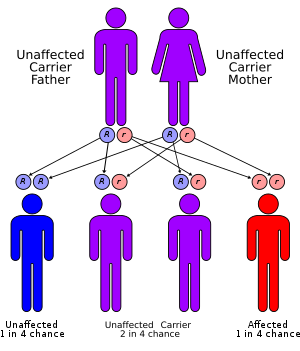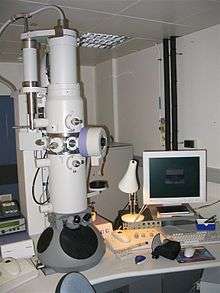Acrodermatitis enteropathica
Acrodermatitis enteropathica is an autosomal recessive metabolic disorder affecting the uptake of zinc through the inner lining of the bowel, the mucous membrane. It is characterized by inflammation of the skin (dermatitis) around bodily openings (periorificial) and the tips of fingers and toes (acral), hair loss (alopecia), and diarrhea. It can also be related to deficiency of zinc due to other, i.e. congenital causes.[3][4]
| Acrodermatitis enteropathica | |
|---|---|
| Other names | Acrodermatitis enteropathica, zinc deficiency type[1] |
 | |
| Acrodermatitis enteropathica inheritance | |
| Specialty | Endocrinology |
| Symptoms | Dry skin, Emotional lability, Blistering of skin[2] |
| Causes | Mutation of the SLC39A4 gene[3] |
| Diagnostic method | Skin biopsy, Plasma zinc level[3] |
| Treatment | Dietary zinc supplementation[1] |
Other names for acrodermatitis enteropathica include Brandt syndrome and Danbolt–Cross syndrome.[5]
Signs and symptoms
Individuals with acrodermatitis enteropathica may present with the following:[2]
Alopecia (loss of hair from the scalp, eyebrows, and eyelashes) may occur. Skin lesions may be secondarily infected by bacteria such as Staphylococcus aureus or fungi such as Candida albicans.[6]
This condition can be fatal in infants. As such, symptoms typically present rapidly (within first days of life) in infants who are formula fed, or promptly after children stop breastfeeding. Older children with Acrodermatitis Enteropathica are also commonly observed to have a lack of growth. This includes dwarfism, delayed puberty, or hypogonadism (in biological males).[7]
Genetics
Acrodermatitis enteropathica, in terms of genetics, indicates that a mutation of the SLC39A4 gene on chromosome 8 q24.3 is responsible for the disorder. The SLC39A4 gene encodes a transmembrane protein that serves as a zinc uptake protein. The features of the disease usually start manifesting as an infant is weaned from breast milk. Zinc is very important as it is involved in the function of approximately 100 enzymes in the human body.[3][1][8][9]
Diagnosis

The diagnosis of an individual with acrodermatitis enteropathica includes each of the following:[3]
- Plasma zinc level (lab)
- Light microscopy (skin biopsy)
- Electron microscopy (histology)
Treatment
Acrodermatitis enteropathica without treatment is fatal, and affected individuals may die within a few years. There is no cure for the condition. Treatment includes lifelong dietary zinc supplementation.[1]
See also
References
- RESERVED, INSERM US14 -- ALL RIGHTS. "Orphanet: Acrodermatitis enteropathica". www.orpha.net. Retrieved 18 February 2017.
- "Acrodermatitis enteropathica | Genetic and Rare Diseases Information Center (GARD) – an NCATS Program". rarediseases.info.nih.gov. Retrieved 2017-02-18.
- "Acrodermatitis Enteropathica: Background, Pathophysiology, Epidemiology". 2017-01-10. Cite journal requires
|journal=(help) - Sehgal, V. N.; Jain, S. (2000-11-01). "Acrodermatitis enteropathica". Clinics in Dermatology. 18 (6): 745–748. doi:10.1016/s0738-081x(00)00150-4. ISSN 0738-081X. PMID 11173209.
- Stedman, Thomas Lathrop. 2005. Stedman's Medical Eponyms. Baltimore: Lippincott Williams & Wilkins, p. 170.
- "Acrodermatitis Enteropathica, DermNet New Zealand".
- Khan Mohammad Beigi, Pooya & Maverakis, Emanual. (2015). Acrodermatitis Enteropathica A Clinician's Guide. 10.1007/978-3-319-17819-6.
- Reference, Genetics Home. "SLC39A4 gene". Genetics Home Reference. Retrieved 2017-02-18.
- Kasana, Shakhenabat; Din, Jamila; Maret, Wolfgang (1 January 2015). "Genetic causes and gene–nutrient interactions in mammalian zinc deficiencies: Acrodermatitis enteropathica and transient neonatal zinc deficiency as examples". Journal of Trace Elements in Medicine and Biology. 29: 47–62. doi:10.1016/j.jtemb.2014.10.003. PMID 25468189. – via ScienceDirect (Subscription may be required or content may be available in libraries.)
Further reading
- Beigi, Pooya Khan Mohammd; Maverakis, Emanual (2015). Acrodermatitis Enteropathica: A Clinician's Guide. Springer. ISBN 9783319178196. Retrieved 18 February 2017.
- "OMIM Entry - # 201100 - ACRODERMATITIS ENTEROPATHICA, ZINC-DEFICIENCY TYPE; AEZ". www.omim.org. Retrieved 18 February 2017.
- Gupta, Mrinal; Mahajan, Vikram K.; Mehta, Karaninder S.; Chauhan, Pushpinder S. (1 January 2014). "Zinc Therapy in Dermatology: A Review". Dermatology Research and Practice. 2014: 709152. doi:10.1155/2014/709152. ISSN 1687-6105. PMC 4120804. PMID 25120566.
External links
| Classification | |
|---|---|
| External resources |